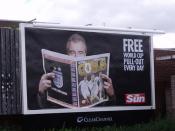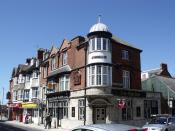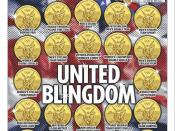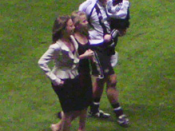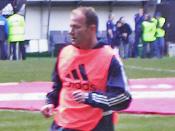Media assignment EN1 Both of the articles being analysed are reporting on the same event, the victory of the English football team at an international competition in 1996. Despite this similarity, both articles present the information in a distinctly different way, with differences in language, presentation and layout amongst many other things. This is because each article belongs to two different newspapers. The sun is a tabloid aimed at a wider range of audience where as The Times is a broadsheet, which has a certain choice.
The analysis of the Times and Sun front pages produces completely different results. For example, the Times article has a big picture, but still has more writing than the Sun's front page. The Times is more detailed than the Sun. The Times does not usually have large pictures but they have this time for the England-Holland match, which shows that the importance of the match is great.
The Sun on the other hand usually has a large pictures and less text.
The Sun uses play on words in their headlines. It was, "ÃÂEngland 4 Ever.' The number four is emphasising the four goals England scored.
The proportion of the title is larger in the Sun than the Times. The Sun has two titles, "ÃÂEngland 4 Ever', and "ÃÂDutch Hammered, now bring on the Spanish'. This is a very victorious and aggressive heading. The text on the front-page of the tabloid and broadsheet are completely different. The Times uses standard English for those who are not entertained or challenged by slang and colloquialisms . The Sun uses language, which suits the less formal person. News is not the only main factor. Advertisements are more common in tabloids than broadsheets. For instance different adverts would be printed in the two. Adverts which appeal to business men would be printed in the Times, and individuals who want a quick simple read would read and view adverts in the Sun.
The layout of the sports page in the Sun has more picture than writing. The photograph taken from England's glorious scored goals; take a large proportion of the page. They emphasise the fact that all four goals were great by printing a picture of each of them. This persuades the reader to carry on viewing the article, and find out more information about the four goals scored.
A person reading the Times would more likely be a business man, so he wouldn't need to view a picture in order to read the article with enjoyment.
The Times article is clearly an in-depth analysis of the match and is a lengthy piece of writing. It is carefully structured, beginning with the main summary of the match, its date and location, its historical significance and England's brilliant performance. It does this in one paragraph which shows that the concise, precise language is to the point and can convey so much information without wasting words. The paragraphs vary in size but usually they are long and detailed with much information condensed in them.
The sheer length of sentences achieves this concise style of reporting on the match. The fact that some sentences can go on over four lines means that more facts can be inserted without making the article long and boring. However this is not to say that the length of the sentences make the piece any less grammatical, the sentences are complex and contain many clauses and technical devices of grammar.
"With a display of pace, passion and power, England trounced Holland at Wembly, earning them the right to play Spain in the stadium quarter-finals on Saturday afternoon."ÃÂ The sentence has three parts, each conveying different information abou the match.
It then goes to describe the rest of the match commenting on the general performance of each team at various points in the match, the emotional reaction of the crowd, the performance of key players, bookings and exciting descriptions of each goal scored.
This article has a formal register and does not wish do use anything else to try and make it more exciting for the reader. The colourful description and detailed analysis of the match is what the audience desires. It does not rely upon slang or colloquialisms to make the commentary more enjoyable and uses a more subtle approach.
The phrase "ÃÂpace, passion and power' consists of three short and sharp words which describe the magnificent performance and the alliteration adds to this effect.
The use of "ÃÂsuch a night, such a performance..' is effective because of the repetition and this emphasises on the absolute skill shown. The goal that Holland scored at the end, which gave them comfort is conveyed simply as, the "ÃÂconsolation goal', and the fact that they had four goals passed them is pout across with "ÃÂa four goal deficit' The vocabulary is clearly advanced and certain words are used which successfully convey what is desired. Some examples are "ÃÂjackknifed', "ÃÂirrepressible', "ÃÂpoached' and "ÃÂimpudently' are examples.
The article is serious throughout and does not really upon humour, as it simply wishes to report an event to the reader. Though it does praise England, in this case, it is deserved as England had a spectacular win and Holland showed a poor performance. Even a quote at the end is given by the manager, praising England. But the praise does not become melodramatic and biased, like The Sun, and also comments on the opposition's performance.
It gives a detailed fact of "ÃÂ76 798' English fans, unlike The Sun's "ÃÂ70 000' figure "ÃÂEarly on, Dutch fluidity had threatened England, thrown them back on their heels"æ."àOverall it is a fair, descriptive, informative report of the match.
The Sun's Article has much shorter and with much less information to gain from them. The article is less carefully structured than the Times and each paragraph is not properly linked to the previous one. The sentences can be long but they are less complex and uses less punctuation, mainly commas. This makes them sound tedious and as though drag on to an extent. Generally the style of writing has an informal register, as though the writer is directly addressing the reader, making it less sophisticated and more "ÃÂchatty'.
"ÃÂ Our finest our? Oh boy, you better believe it' is used at the beginning and this grammatically crude and even asks the reader questions. "ÃÂAnd Seaman?', "ÃÂthe best of Europe?' and "ÃÂfootball coming home?' are examples of questions posed by the writer.
In the second two cases the phrase "ÃÂBelieve it.' is used to answer the question in emphatic way. This repetition ends on the climax of "Believe it, boy, believe it.' This is clearly recycling a simple and abrupt phrase continuously, which is not the most sophisticated of ways to entertain the reader.
There are also separated, underlined adjectives in bold and a larger font, inserted between paragraphs. "ÃÂBrilliant' and "ÃÂRapture' are the words, again other methods could be used to praise the team, as opposed to two adjectives.
The article is strongly biased, and shows clear support for England, glorifying their every action. Referring to the players as "ÃÂgladiators, "ÃÂfoot soldiers', '11 heroes' and to the manager as a "ÃÂmastermind'. Also words such as "ÃÂthrashing', "ÃÂbeating', "ÃÂblitzed the Dutch' are used to describe the victory as completely and utterly one-sided. It also uses a comparison of Alan Shearer to someone with "ÃÂsavage claws' attacking the team and drawing "ÃÂFirst blood', this is highly melodramatic.
The goal scored by the opposition is described as lucky and a colloquialism is used, modified to be humorous and to an extent mock Holland. "ÃÂ..saved their Dutch bacon..' is the phrase used. Also nicknames are used for the players, for example, Paul Gascgoine is referred to as "ÃÂGazza'.
Overall the article from The Sun is much easier to read and does things in ways which are easier to pick up on. Instead of describing the actions of players and their manoeuvres when scoring goals, pictures are used. The language of The Times article is much more sophisticated and a significant proportion of football fans may find it less comprehensible. The Times is much more informative and gives a much fairer account of the match. To say which is more entertaining is difficult, as some may be pleased by humour, slang and informality, whereas others by a good analysis of the match. But personally I found The Times more entertaining because it gave more information and my aim is to inquire about the match details. Also The Sun was much more biased.
These differences gain can be explained by the differences in audiences. The Times is aimed at a particular audience who demand a certain standard and this must be adhered to. The Sun aims at the widest range possible of audience and tries to make it as accessible as possible. Overall, they report on the event in two distinct ways, for two distinct purposes.
